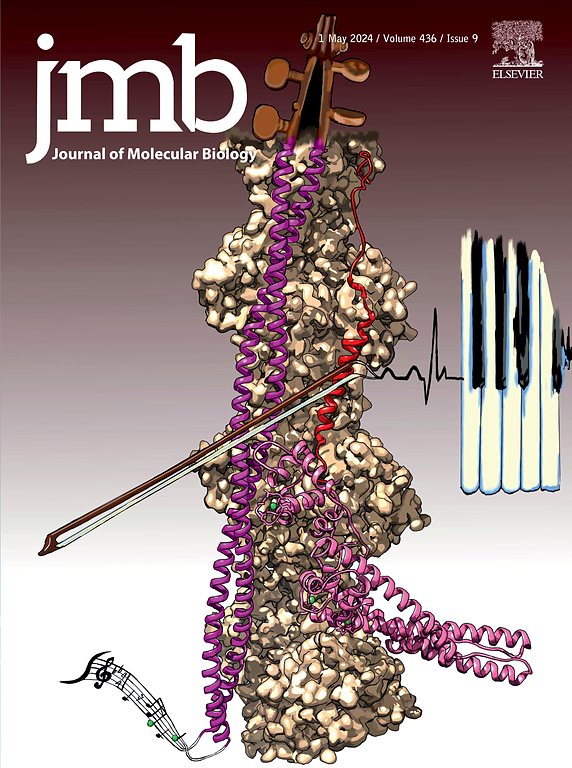Pioneer in Molecular Biology: Conformational Ensembles in Molecular Recognition, Allostery, and Cell Function
IF 4.7
2区 生物学
Q1 BIOCHEMISTRY & MOLECULAR BIOLOGY
引用次数: 0
Abstract
In 1978, for my PhD, I developed the efficient O(n3) dynamic programming algorithm for the-then open problem of RNA secondary structure prediction. This algorithm, now dubbed the “Nussinov algorithm”, “Nussinov plots”, and “Nussinov diagrams”, is still taught across Europe and the U.S. As sequences started coming out in the 1980s, I started seeking genome-encoded functional signals, later becoming a bioinformatics trend. In the early 1990s I transited to proteins, co-developing a powerful computer vision-based docking algorithm. In the late 1990s, I proposed the foundational role of conformational ensembles in molecular recognition and allostery. At the time, conformational ensembles and free energy landscapes were viewed as physical properties of proteins but were not associated with function. The classical view of molecular recognition and binding was based on only two conformations captured by crystallography: open and closed. I proposed that all conformational states preexist. Proteins always have not one folded form—nor two—but many folded forms. Thus, rather than inducing fit, binding can work by shifting the ensembles between states, and this shifting, or redistributing the ensembles to maintain equilibrium, is the origin of the allosteric effect and protein, thus cell, function. This transformative paradigm impacted community views in allosteric drug design, catalysis, and regulation. Dynamic conformational ensemble shifts are now acknowledged as the origin of recognition, allostery, and signaling, underscoring that conformational ensembles—not proteins—are the workhorses of the cell, pioneering the fundamental idea that dynamic ensembles are the driving force behind cellular processes. Nussinov was recognized as pioneer in molecular biology by JMB.

分子生物学先驱:分子识别、变构和细胞功能中的构象集成。
这些年来,我的关注点发生了变化。1978年,我开发了一种有效的0 (n3)动态规划算法,用于RNA二级结构预测的开放问题。这种算法,现在被称为“Nussinov算法”、“Nussinov图”和“Nussinov图”,在欧洲和美国的课堂上仍然教授。随着序列在20世纪80年代开始出现,我开始寻找基因组编码的功能信号,后来成为生物信息学的趋势。在20世纪90年代初,我转到蛋白质领域,参与开发了一种强大的基于计算机视觉的对接算法。在20世纪90年代末,我提出了构象系在分子识别和变构中的基础作用。当时,构象集成和自由能景观被视为蛋白质分子的物理性质,但与功能无关。分子识别和结合的经典观点仅基于晶体学捕获的两种构象:开放和封闭。我提出所有的构象状态都是预先存在的。蛋白质不是只有一种折叠形式,也不是有两种,而是有多种折叠形式。因此,结合不是诱导契合,而是通过在不同状态之间转移组合来起作用,而这种转移或重新分配组合以保持平衡,是变构效应和蛋白质(从而细胞)功能的起源。这种新模式影响了社会对变构药物设计、催化和调控的看法。动态的构象集合变化现在被认为是识别、变构和信号传导的起源,强调构象集合——而不是蛋白质——是细胞的主力,开创了动态集合是细胞过程背后驱动力的基本观点。
本文章由计算机程序翻译,如有差异,请以英文原文为准。
求助全文
约1分钟内获得全文
求助全文
来源期刊

Journal of Molecular Biology
生物-生化与分子生物学
CiteScore
11.30
自引率
1.80%
发文量
412
审稿时长
28 days
期刊介绍:
Journal of Molecular Biology (JMB) provides high quality, comprehensive and broad coverage in all areas of molecular biology. The journal publishes original scientific research papers that provide mechanistic and functional insights and report a significant advance to the field. The journal encourages the submission of multidisciplinary studies that use complementary experimental and computational approaches to address challenging biological questions.
Research areas include but are not limited to: Biomolecular interactions, signaling networks, systems biology; Cell cycle, cell growth, cell differentiation; Cell death, autophagy; Cell signaling and regulation; Chemical biology; Computational biology, in combination with experimental studies; DNA replication, repair, and recombination; Development, regenerative biology, mechanistic and functional studies of stem cells; Epigenetics, chromatin structure and function; Gene expression; Membrane processes, cell surface proteins and cell-cell interactions; Methodological advances, both experimental and theoretical, including databases; Microbiology, virology, and interactions with the host or environment; Microbiota mechanistic and functional studies; Nuclear organization; Post-translational modifications, proteomics; Processing and function of biologically important macromolecules and complexes; Molecular basis of disease; RNA processing, structure and functions of non-coding RNAs, transcription; Sorting, spatiotemporal organization, trafficking; Structural biology; Synthetic biology; Translation, protein folding, chaperones, protein degradation and quality control.
 求助内容:
求助内容: 应助结果提醒方式:
应助结果提醒方式:


